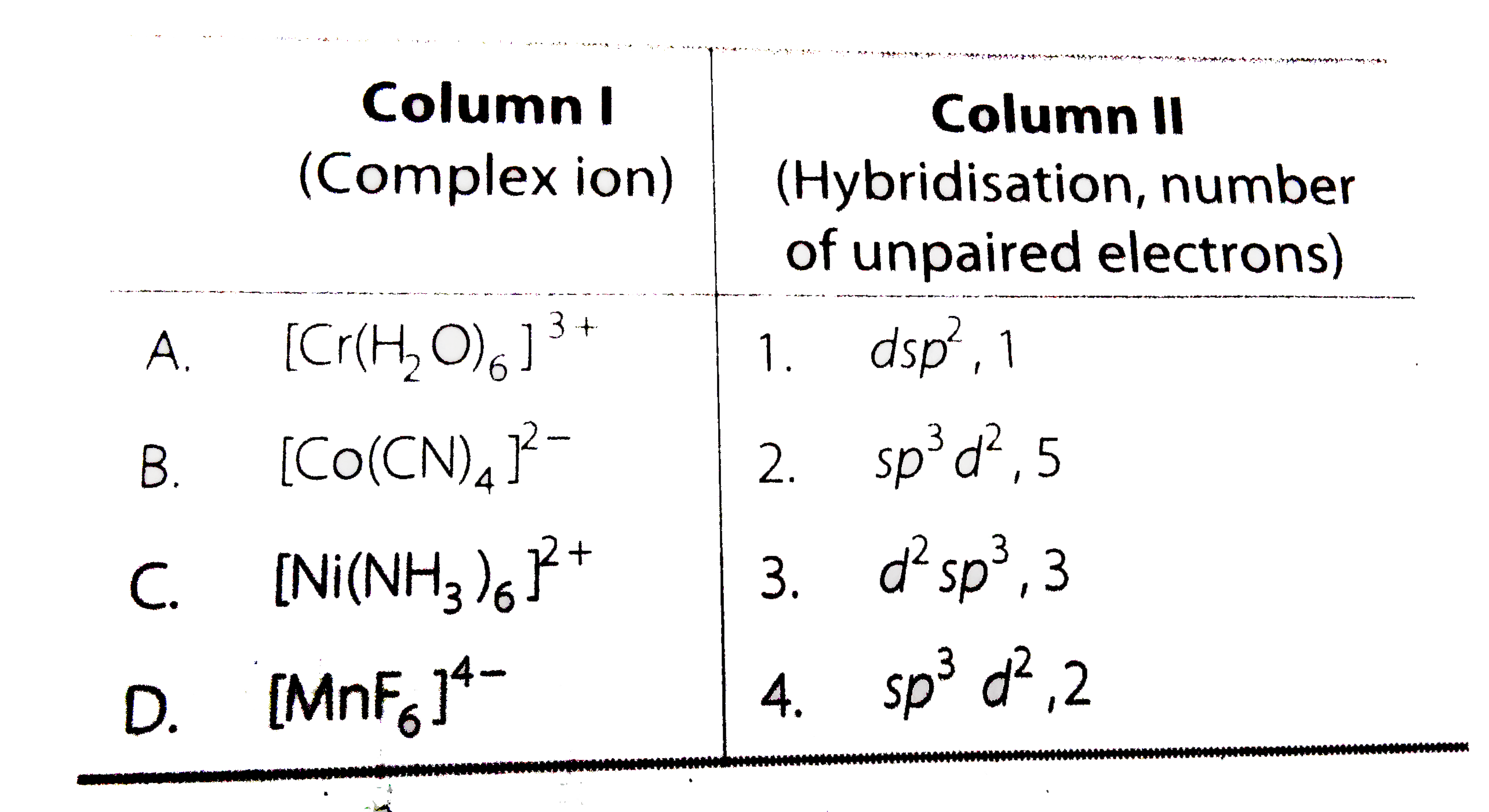Match the compounds given in Column I with the oxidation state of cobalt present in it (given in Column II) and assign the correct code.
Column I (Compound)Column I (Oxidation state of Co)A.[Co(NCS)(NH3)5](SO3)1.+4B.[Co(NH3)4Cl2]SO42.0C.Na4[Co(S2O3)3]3.+1D.[Co2(CO)8]4.+25.+3
A (1)B (2)C (4)D (5)
A (4)B (3)C (2)D (1)
A (5)B (1)C (4)D (2)
A (4)B (1)C (2)D (3)
The correct Answer is:c
To solve the problem of matching the compounds with the oxidation states of cobalt, we will analyze each compound in Column I and determine the oxidation state of cobalt in each case.
Step 1: Analyze Compound A - (Co(NCS)(NH3)5)(SO3)
- Ligands: NCS (−1 charge), NH3 (neutral, 0 charge), SO3 (−2 charge).
- Let the oxidation state of cobalt be x.
- The equation for the charge balance is:
x−1+0−2=0
- Simplifying gives:
x−3=0⟹x=+3
Step 2: Analyze Compound B - (Co(NH3)4Cl2)SO4
- Ligands: NH3 (neutral, 0 charge), Cl (−1 charge), SO4 (−2 charge).
- Let the oxidation state of cobalt be x.
- The equation for the charge balance is:
x+0−1×2−2=0
- Simplifying gives:
x−2−2=0⟹x=+4
Step 3: Analyze Compound C - Na4(Co(S2O3)3)
- Ligands: Na (each +1 charge, total +4 for 4 Na), S2O3 (−2 charge).
- Let the oxidation state of cobalt be x.
- The equation for the charge balance is:
4+x−2×3=0
- Simplifying gives:
4+x−6=0⟹x=+2
Step 4: Analyze Compound D - (Co2(CO)8)
- Ligands: CO (neutral, 0 charge).
- Let the oxidation state of cobalt be x.
- The equation for the charge balance is:
2x+0=0
- Simplifying gives:
2x=0⟹x=0
Summary of Findings:
- Compound A: Oxidation state of Co = +3
- Compound B: Oxidation state of Co = +4
- Compound C: Oxidation state of Co = +2
- Compound D: Oxidation state of Co = 0
Matching with Column II:
- A matches with +3 (5)
- B matches with +4 (1)
- C matches with +2 (4)
- D matches with 0 (2)
Final Code Assignment:
- A - 5
- B - 1
- C - 4
- D - 2
Thus, the correct option is 3.
- Ligands: NCS (−1 charge), NH3 (neutral, 0 charge), SO3 (−2 charge).
- Let the oxidation state of cobalt be x.
- The equation for the charge balance is:
x−1+0−2=0
- Simplifying gives:
x−3=0⟹x=+3
- Ligands: NH3 (neutral, 0 charge), Cl (−1 charge), SO4 (−2 charge).
- Let the oxidation state of cobalt be x.
- The equation for the charge balance is:
x+0−1×2−2=0
- Simplifying gives:
x−2−2=0⟹x=+4
- Ligands: Na (each +1 charge, total +4 for 4 Na), S2O3 (−2 charge).
- Let the oxidation state of cobalt be x.
- The equation for the charge balance is:
4+x−2×3=0
- Simplifying gives:
4+x−6=0⟹x=+2
- Ligands: CO (neutral, 0 charge).
- Let the oxidation state of cobalt be x.
- The equation for the charge balance is:
2x+0=0
- Simplifying gives:
2x=0⟹x=0
- Compound A: Oxidation state of Co = +3
- Compound B: Oxidation state of Co = +4
- Compound C: Oxidation state of Co = +2
- Compound D: Oxidation state of Co = 0
- A matches with +3 (5)
- B matches with +4 (1)
- C matches with +2 (4)
- D matches with 0 (2)
- A - 5
- B - 1
- C - 4
- D - 2
Topper's Solved these Questions
- BOOK - PRADEEPCHAPTER - CORDINATION COMPOUNDSEXERCISE - Assertion And Reason Types Question5videos
CORDINATION COMPOUNDS
- BOOK - PRADEEPCHAPTER - CORDINATION COMPOUNDSEXERCISE - Long Answer Questions7videos
CORDINATION COMPOUNDS
- BOOK - PRADEEPCHAPTER - CORDINATION COMPOUNDSEXERCISE - Short Answer Questions64videos
CORDINATION COMPOUNDS
- BOOK - PRADEEPCHAPTER - CHEMISTRY IN EVERYDAY LIFE EXERCISE - IMPORTANT QUESTION FOR BOARD EXAMINATION30videos
CHEMISTRY IN EVERYDAY LIFE
- BOOK - PRADEEPCHAPTER - D- AND F-BLOCK ELEMENTSEXERCISE - IMPORTANT QUESTIONS30videos
D- AND F-BLOCK ELEMENTS
Similar Questions
Knowledge Check
- Question 1 - Select One or More
Match the compounds given In column I with oxidation state of cabalt present in it (given in column II) and assign the correct code.
 AABCD1243BABCD4321CABCD3142DABCD4132
AABCD1243BABCD4321CABCD3142DABCD4132 - Question 2 - Select One
Match the complen ions given in column 1 with the hybridisation and number of unpaired electrons given in column 2 ad assign the correct code.
Column 1Column 2(A)[CO(NCS)(NH3)5](SO3)(1)+4(B)[Co(NH3)4CI2]SO4(2)0(C)[CO(S2O3)3]Na4(3)+1(D)[CO2(CO)8]((4)+2)(5)+3AA-1,B-2,C-4,D-5BA-4,B-3,C-2,D-1CA-5,B-1,C-4,D-2DA-4,B-2,C-2,D-3 - Question 3 - Select One
Match the complex ions given in Column I with the colours given the Column II and assign the correct code :
Column I (Complex ion)Column II (Colour)A.[Co(NH3)6]3+1.VioletB.[Ti(H2O)6]3+2.GreenC.[Ni(H2O)6]2+3.Pale blueD.[Ni(H2O)4(en)]2+(aq)4.Yellowish organge5.BlueAA (1)B (2)C (4)D (5)BA (4)B (3)C (2)D (1)CA (3)B (2)C (4)D (1)DA (4)B (1)C (2)D (3)
Match the complex species given in Column I with the possible isomerism given in Column II and assign the correct code :
Column I (Complex species)Column II (Isomerism)A.[Co(NH3)4Cl2]+1.opticalB.cis−[Co(en)2Cl2]+2.ionisationC.[Co(NH3)5(NO2)]Cl23.coordinationD.[Co(NH3)6][Cr(CN)6]4.geometrical5.linkageView SolutionThe oxidation state of Co in [Co(NH3)5Cl]Cl2.
View Solution[Co(NH3)4(SCN)2]+ and [Co(NH3)4(NCS)2]+ are :
View Solution[Co(NH3)4(SCN)2]+ and [Co(NH3)4(NCS)2]+ are :
View SolutionMatch the compounds given in column I with oxidation states of carbon given in column II and mark the appropriate choice.
Column IColumn II(A)C6H12O6 (i) +3(B)CHCl3 (ii) -3(C)CH3CH3 (iii) +2(D)(COOH)2 (iv) 0View Solution


